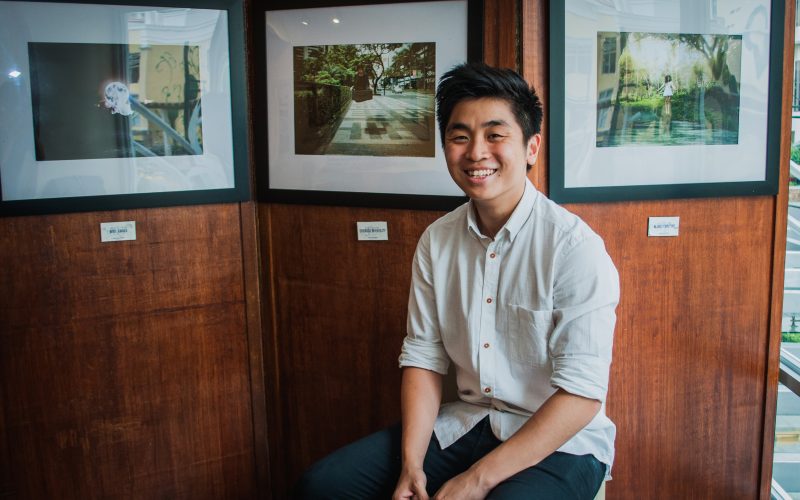Nicholai Go: Bar Dolci’s Owner Is a Man on a Mission
The young entrepreneur shares his journey into photography, his safe spots and his vision for the future

Nicholai David Go may be fresh out of college but the 24-year old has been hard at work since he was a teenager. He is the man behind top dessert café Bar Dolci, a venture he started when he was just 15 years old that has now evolved to one of the largest gelato and macaron suppliers for hotels and restaurants in Manila. After finishing his Architecture degree from Rhode Island School of Design, he’s now working on establishing his own design firm along with laying the ground for Litrato, a non-government organization that aims to elevate the lives of Filipinos through photography.
Here, he shares his journey into photography, his safe spots and his vision for the future.
- What first got you into photography?
I started back in senior year in high school. I’ve always been a traditional artist and used pencil and paper, paint and canvas. Then I was taking up the International Baccalaureate Program and I had to come up with 18 pieces for the year. I finished early so my teacher challenged me to try a different medium and pushed me towards photography. I thought photography was the lazy man’s art because it looked so simple to take a photo compared to hours of labor for painting. Then I realized how much work goes into a photo and I fell in love with it and how you can tell so many stories in one photograph.
- What are some of your favorite shoot locations?
The New York skyline is always really nice. Providence, Rhode Island is a little quiet and there are a lot of hidden areas that you can find like an abandoned railway. I like walking around and looking for places that wouldn’t normally be noticed.
- What are your favorite subjects to shoot?
I’m more into directorial photography. I like to direct everything in the shot and that often involves telling a story as part of a series where the character goes through different experiences. The location itself can be identified but the world that the model occupies is something I make myself.
- What was one of your memorable projects for school?
I was granted a fellowship by Massachusetts General Hospital and had the opportunity to fly to Kenya. I stayed there for three weeks for the project, which was for a studio called African Institute for Health Transformation. The goal was to redesign Sagam Hospital to show the owner the added benefits of an architect in the masterplanning design process.
- Were you able to travel around the States as well?
Yes, mostly in the East Coast – New York, Massachusetts, Boston. I always bring a camera with me. It’s hard to find a model to shoot with so I tend to shoot landscapes mostly when I’m in the States to practice my eye.
- Where did you go on your last vacation?
My family and I went to Israel with a rabbi we met here in Manila so that was interesting. We’re close with the Jewish community here and when we had the chance to go to Israel, we invited him. We got to visit places that would usually be restricted to other people.
- What’s your favorite Philippine destination?
It’s still Tagaytay. It’s convenient for me to go to, very relaxing, and the area is very clean. I’m not that adventurous when it comes to traveling because I like my safe spots but when I have my camera it changes. That’s when I feel really compelled to travel to places I wouldn’t normally go to.
- Do you have a dream destination?
There are places that I really want to visit because of the architecture. I’ve been to Italy and Rome but I wasn’t able to go to the places I wanted to go to. I want to see Le Corbusier’s work all over the world and I want to see the metabolist architecture in Japan.
- How do you envision Litrato?
The reason I started Litrato was to give voice to people that don’t and give them the space where they can show their work. I turned Bar Dolci into a gallery and I’m hoping to partner with hotels and create more spaces where people can see and appreciate good work.
For this year, we’ll start with partnering with NGOs and teaching unfortunate children and people who don’t have access to cameras. Hopefully by next year, we get connected to high schools so that we can teach students how to take good photographs.
- What keeps you inspired?
I’d like to think that everything I do is geared towards helping the Philippines. Getting into photography was about creating a voice so that I can share my experiences and blessings as well as help others showcase their talents. For architecture, it’s about building cities and infrastructure the proper way. For food, it’s about trying to elevate people’s palates and the quality of food. There are a lot of things I’m doing but what keeps me inspired is the sense of agency that I have to create change.
+ 1: What do you hope to achieve before you turn 30?
I’d really like to stabilize my business and make Litrato grow and spread across the Philippines. Architecture-wise, I want to get my hands involved in city planning. The way I’m starting it is looking into healthcare. I’d really like to get a set of hospitals done before I turn 30.
Photo By Mike Alegado